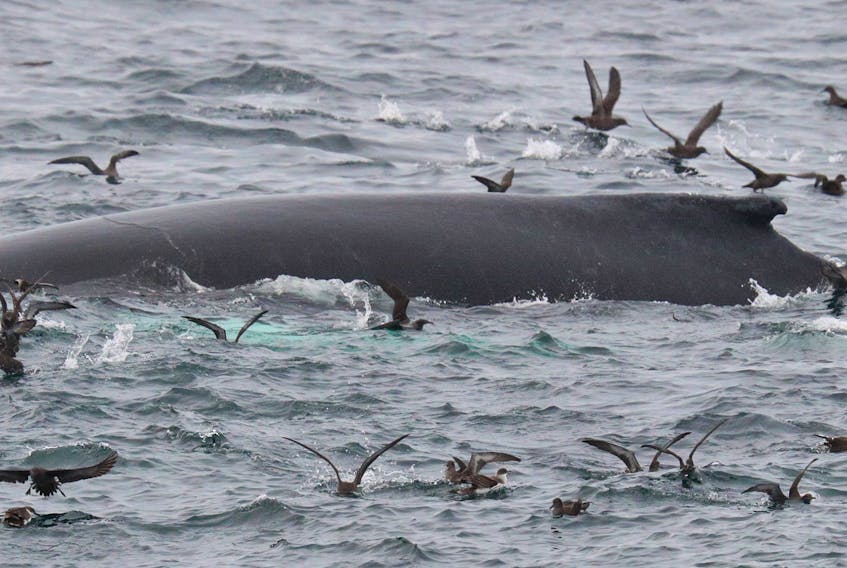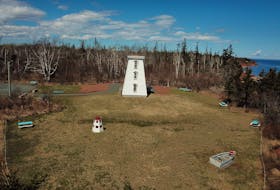It is the season of the caplin. Hardly any other fish in the province evokes excitement the way that the caplin does.
Caplin have been an important part of Newfoundland and Labrador culture since the beginning of human habitation. Its abundance meant it was a food source but it was also used to fertilize the potato and turnip gardens.
Nowadays caplin also has an entertainment value.

Besides rolling up on the beaches in silvery masses they also bring in the whales by the busload. Like icebergs, people can never get enough of whales, and viewing them while standing on terra firma is a great extra. St. Vincent’s beach on the southern Avalon Peninsula has been hot for whales this month.
The humpbacks are numerous as they gorge on caplin just off the beach. Droves of people visiting St. Vincents are getting their whale fix.
Whales are feeding on caplin all around the Avalon Peninsula and various other locations around the province right now. There are also fin and minke whales among the abundant humpbacks.
Birders going to St. Vincent’s beach are looking between the humpback whales for seabirds. Squadrons of gannets drop like torpedoes from the sky into the shoals of caplin catching them by surprise. Gulls, terns and kittiwakes follow the feeding whales snatching caplin forced to the surface by the cavernous mouths of the whales coming at them from below.
Birds congregate on the beach digesting their catch of the day before going back for seconds.
The concentration of caplin just off the beach brings seabirds in off the high seas.
The shearwaters at home on the trackless open ocean are enticed close to the land by the exceptional dining possibilities.
At times thousands of sooty shearwaters overcome their shyness of the land and make daring raids in close to the beach to get a share of the caplin load. There are few places in the world where one can stand on the shore and see large numbers of shearwaters so close.
A few great and manx shearwaters are present among the throngs of sooty shearwaters.
Birders are also keeping an eye out for the rarities among the masses of feasting birds. Nice birds like a long-tailed jaeger, laughing gull and a couple of Caspian terns have been the rarity spice so far.
We will see what else gets drawn in before the caplin season is up in early August.
The seabird nesting colonies on the coasts of Newfoundland depend heavily on the abundance of caplin to ensure a successful breeding season. The Avalon Peninsula seabird nesting colonies are spectacularly huge because of the annual source of caplin during the summer.
Cape St. Mary’s at the southwest corner of the Avalon Peninsula is but two and a half hour drive from St. John’s. Here thousands of gannets attend nests on Bird Rock just a narrow chasm away from solid ground where people can stand comfortably and watch a phenomenal nature show on a great big natural screen. Free natural effects are the wind blowing through your hair and the slight twinge of bird guano stimulating your nostrils. The sheer rock faces are lined with nesting murres, razorbills and kittiwakes. The raucous show is non-stop seven days a week from June into August.
It is not the only show in town.
The Witless Bay seabird islands are second to none for class and utter abundance of birds.
For example there are more than a half million puffins nesting in the Witless Bay Ecological Reserve. And they make up only a portion of the total population of seabirds nesting on the three islands, Gull, Green and Great. Thousands of kittiwake wheel around the cliffs with their calls echoing off the amphitheatre rock walls.
Common murres stand erect on narrow ledges guarding eggs or young while their mates on whirling wings head to the closest known caplin source. Somehow like the honey bees message their co-workers, the murres seem to know which way to go to find the current source of caplin. There are daily boat trips around these islands during the summer customized for the seabird and whale watching needs in us all.
The caplin season is a very busy time for the life in the sea. Respect the caplin. Caplin are the step between the ocean’s zooplankton and the larger lifeforms such as codfish, humpback whales and puffins. As an individual they are but a small silvery fish but as a mass they move mountains of life.
Frounce Update
There was one more suspected case of the parasite frounce found last week making it the second that I am aware of in eastern Newfoundland this summer. It came from Chance Cove, Trinity Bay. It was a pine siskin showing signs of a clogged up throat and general sickness. That feeder watcher took down her feeders and washed them thoroughly.
Tread carefully. It is not an epidemic yet. It may or may not get to that stage.
Stay tuned.
Bruce Mactavish is an environmental consultant and avid birdwatcher. He can be reached at [email protected].
RELATED:









